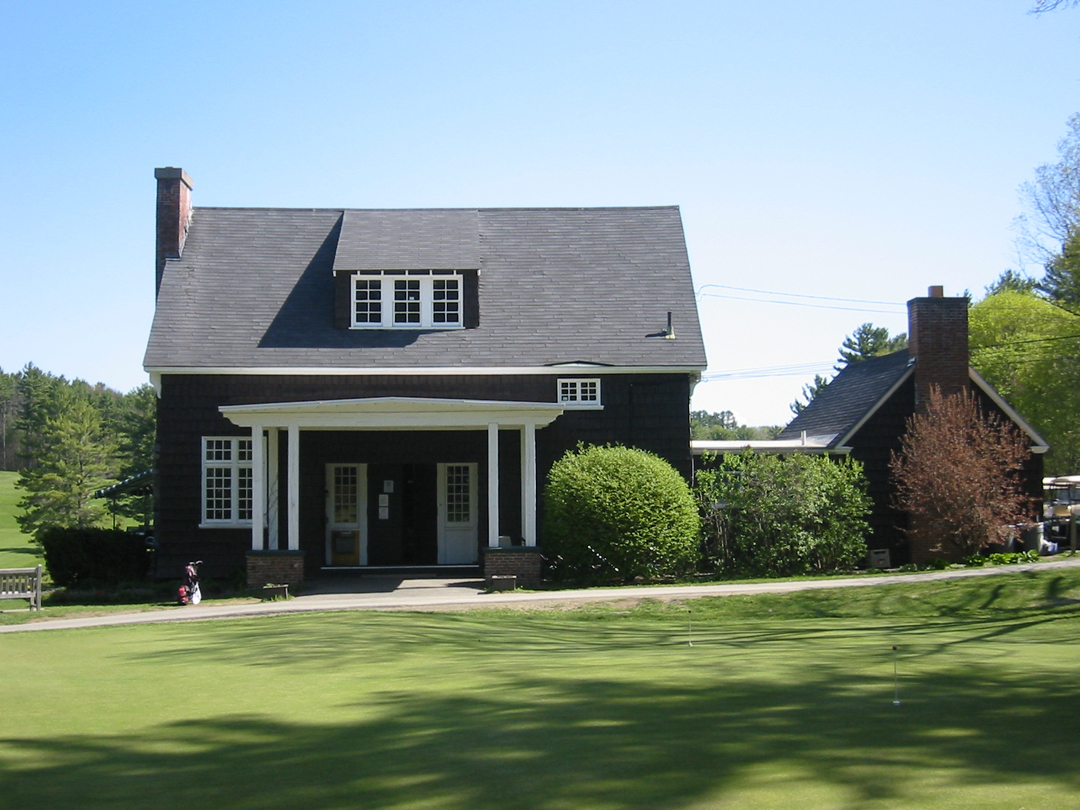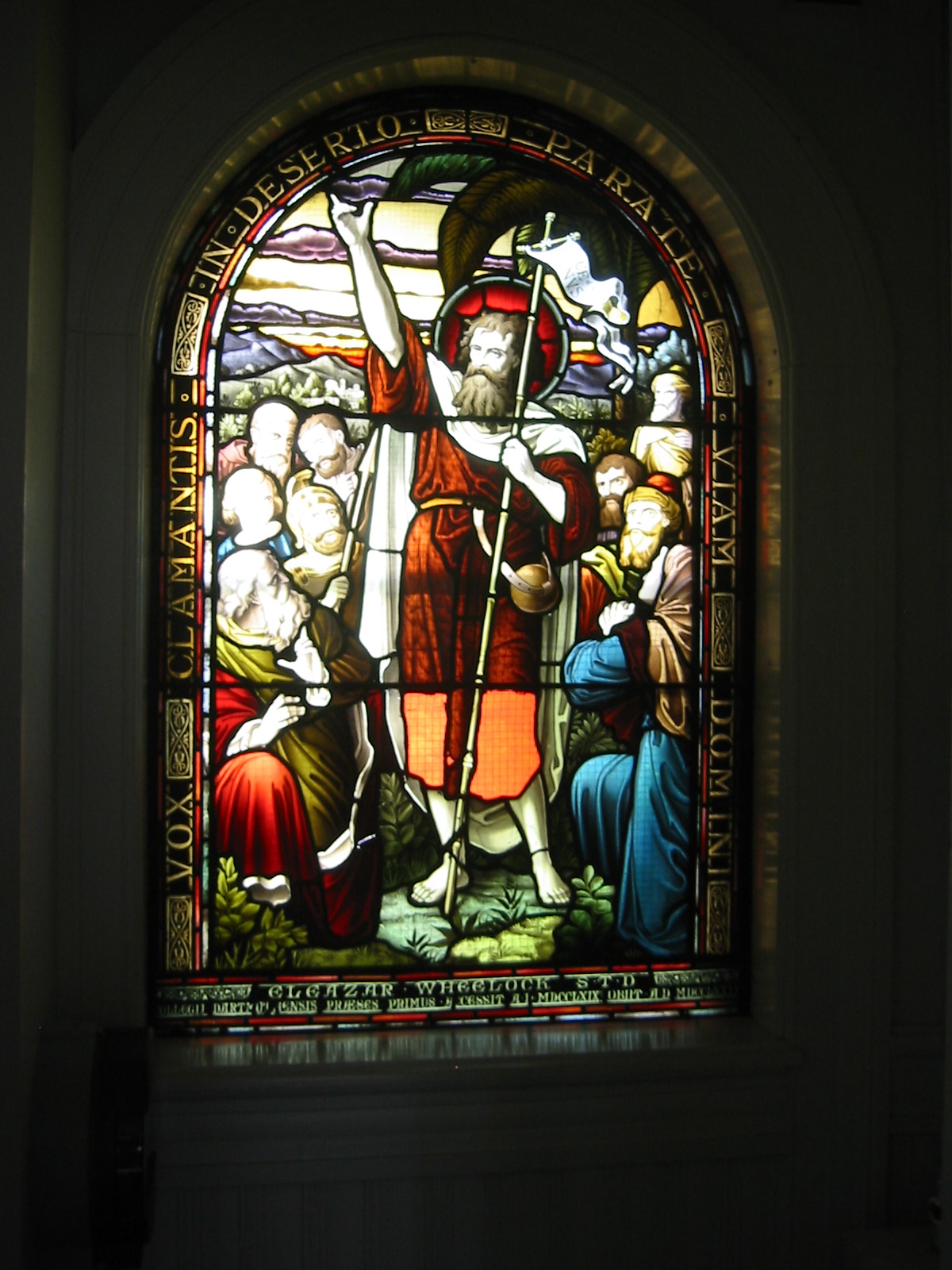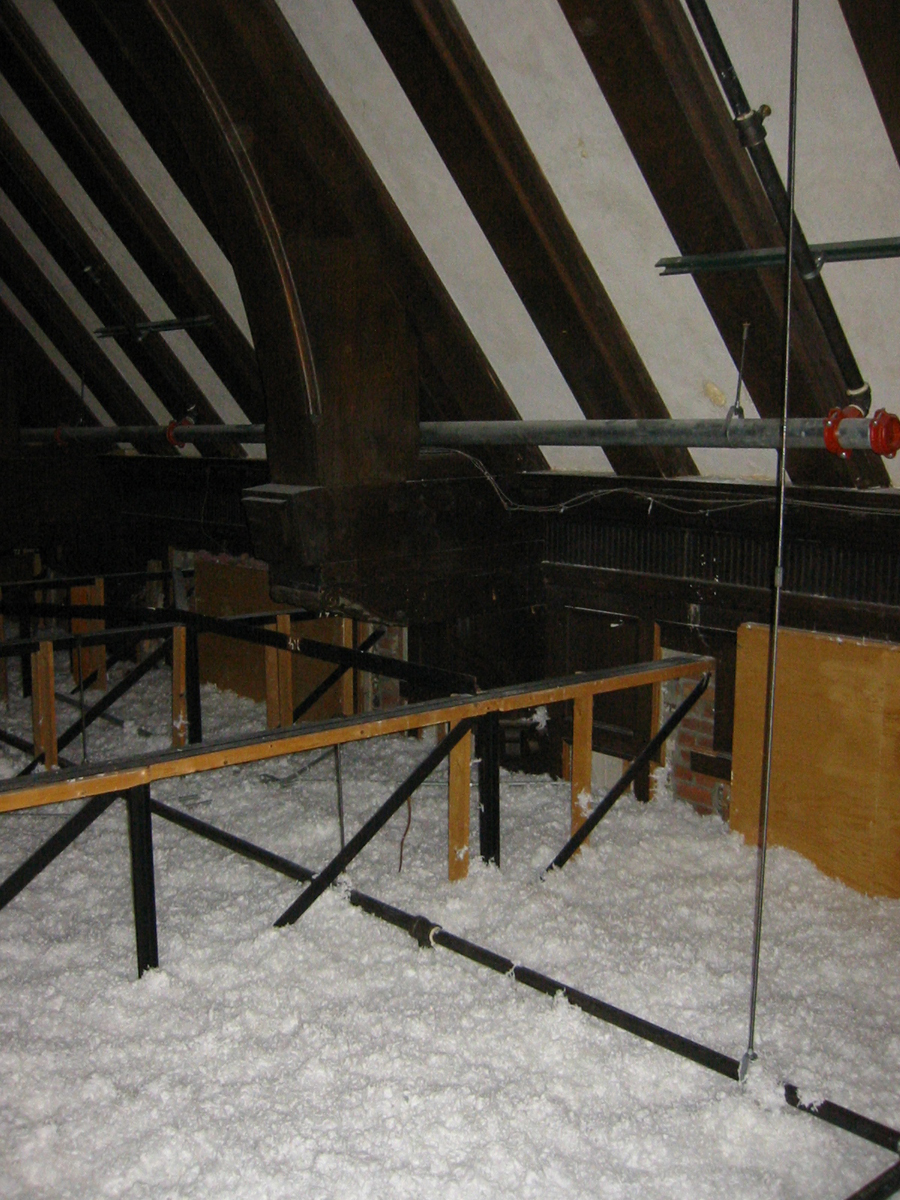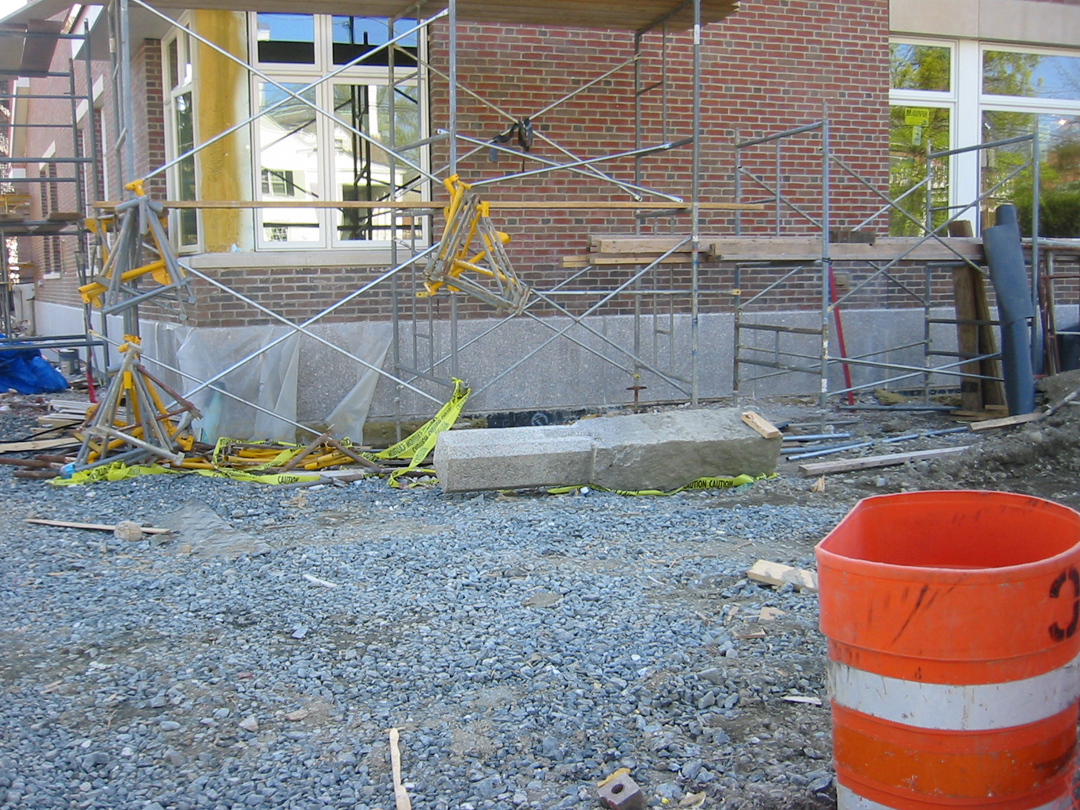The Hanover architect Alfred T. Granger (remembered in the Granger Scholarship [pdf]) was not the same as the well-known Chicago architect Alfred Hoyt Granger, although that is how he was described in the West Wheelock Street Inventory (1993) and elsewhere, including on this website.
Category Archives: History
Thayer School adopts new logo
Last month, the Thayer School of Engineering adopted a new logo that incorporates a shield much more in keeping with those of Dartmouth and its other Associated Schools:
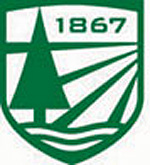
A wavy-lined representation of the Connecticut River now appears in the base of each institution’s shield.
The old logo was less heraldic and had become somewhat dated, although it has the pleasing feature of representing the hills of New Hampshire and Vermont:

—–
[Update 08.31.2013: Broken link to new logo replaced.]
More preservation in the computer age
Google’s recent acquisition of the garage where it began as a company in 1998 and the preservation of the garage where Hewlett and Packard began working in 1938 point out the importance of documenting Bradley and Gerry Halls and marking their sites after they are demolished, since they have some role in the history of computing. Demolition begins as soon as this month.
Bradley is not, however, the place where Kemeny and Kurtz and others created BASIC in 1964, as reported here in “A Plea for the Shower Towers.” A College news release states that BASIC was invented in College Hall, and that is indeed where the school put its GE-235 during February of 1964 after taking delivery of it. BASIC first ran that May and the school moved the machines to the existing Bradley Hall later.
An 1870s expedition to Mount Moosilauke
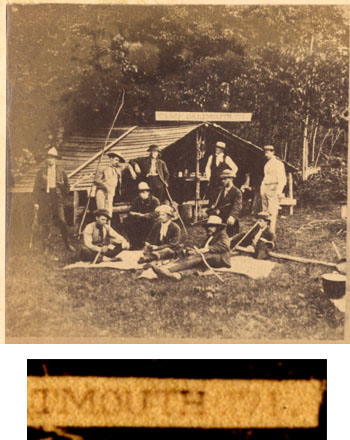
This is one half of an intriguing stereoview. The sign says “Camp Dartmouth” followed by what appear to be an apostrophe, the numerals 71, and a period: Camp Dartmouth ’71. The costumed men in the camp are trying hard not to look like students.
Editors of The Dartmouth explained during the spring of 1870 that an “Expedition to Moosilauk Mountain” was being led by J.H. Huntington of the New Hampshire Geographic Survey, with help from Professor C.H. Hitchcock and several citizens of Warren, including George A. Little ’71. One A.F. Clough, “the finest stereoscopic artist in New Hampshire,” took stereoviews on the mountain. This might be one of those views. The card itself says nothing except “Group Series” on the front.
Dartmouth’s architecture in the news
Many thanks to the Review for mentioning this site in an interview. A few points will always get jumbled over the phone, and this might be a good opportunity to clarify them for the record:
- “National Historic Registry” should read “National Register of Historic Places” and “the register.”
- “There are state and federal tax breaks” should read “There are state and federal tax breaks for renovations. . . . In addition, anything that gets on the list has to have the owner’s permission to get listed.”
- “There are state and federal tax breaks . . . largest in terms of commercial properties but still significant for even a home owner. But the real reason for a college to apply is that it is a blue ribbon” should read “Now, if you’re a college or university that’s not a homeowner and not a business, the real reason to be on the list is because it’s a seal of approval. It’s a blue ribbon. . . . Those tax breaks only come when you renovate your building, generally.”
- “Clement will be supplanted by a new visual arts building designed by McCado and Silveti — a very academic, theoretical type firm — to go on that site” should read “The firm of Machado and Silvetti — big names, a very theoretical, academic-oriented firm — are designing a new visual arts building to go on that site.”
- “Loews — that notoriously hard to find movie theatre — will, I think be moved next to the site on Lebanon Street” should read “Loew’s Auditorium will move from the Hood into this new building, and I have a feeling it will be placed on the street, on Lebanon Street, so that it will become more of a public movie theater.”
- “If you go to Oxford you will typically see a dining hall in the vicinity of the chapel” should read “If you go to Oxford, you will typically see a dining hall in the same ‘range’ ([i.e.] the same building) as the chapel.”
- “I don’t think it should necessarily be torn down or replaced, but it should be amended” should read “I don’t think it’s a terrible building, and I don’t think it should be torn down: I think it should be improved. . . . That said, I think Dartmouth is pretty fortunate to have Murdough and the Choates as their potentially worst buildings.”
- “I suppose the Fairchild center gets a lot of censure, and it is incongruous. But it is cool. And it was meant to be presentable. I don’t think it’s completely convincing. But at least it is presentable” should read “It is incongruous, but at the same time, when you look at it, you can tell . . . there was a sense of style there — there was a lot of skill put into it. It’s very cool and modern — cool in the sense of being refined, you know, the steel and glass, the thin skin. . .”
- “You could make a good argument for making use of the Crosby house (which is the name of the older part), and getting rid of the rest; it makes good use of that space” should read “[Y]ou’ve got all that land south of the building, between Blunt and Parkhurst, basically a vacant lot. . . . . You could make a good argument for a building there that would use the old Crosby House (which is the old part of Blunt), get rid of the rest, and make much better use of that space.”
- “Essentially it was built as a hotel, as part of the town” should read “[T]he Lodge . . . was built . . . effectively as part of the town, as a motel, and then used for a school purpose.”
- “Wheelock set it out back in the 1730s” should read “It’s one of those things that Wheelock set out back in the early 1770s.”
- “The only unfortunate thing is that it blocks access to the grad school . . . I think this is what lead Larsen to propose a large causeway to connect Thayer dining hall area with the graduate part of the campus” should read “The only unfortunate thing about it is that it kind of blocks easy access to the graduate schools. I think there was a plan by Larson in the 1920s that proposed a very long, high causeway or bridge that would have gone from Thayer Dining Hall, basically, across to the Engineering School.”
- “Yes, I hope some of that area is preserved, in particular the buildings . . . should be preserved” should read “although I hope, certainly, that they preserve at least one of those if they do use their sites.”
- “South Fairbanks being the first building designed and built by Charles Rich 1875” should read “He designed it in 1892 . . . [but] Beta , . . . did not build it until around 1903 [after the school had built several buildings designed by Rich].”
New buildings named
A press release on the names of the new dormitories includes two apparent firsts by Dartmouth: the first building, or part of a building, named for Samson Occom (Occom Commons in the McLaughlin Cluster) and the first building given someone’s first name or nickname: McLane Hall is still named for John Roy “Judge” McLane ’07, but it is switching to Judge Hall.
Business education history
Writer Matthew Stewart responds to Tuck Dean Paul Danos’ letter in this month’s Atlantic by stating that “the Tuck School at Dartmouth was indeed founded first, as Paul Danos says; but Harvard was first to offer a master’s degree in business administration.”
This is a petty point, but it’s not clear how Stewart could be correct if he’s referring to the degree in lower-case letters: the Amos Tuck School of Administration and Finance was founded in 1900 and granted its first business master’s degree to Walter Blair and his two classmates in 1901. Harvard did not admit its first students until the fall of 1908.
No graduate degree in the administration of modern businesses existed in 1900. The Tuck School started by calling its degree the “Master of Science (Tuck School)” but renamed it during 1902 the “Master of Commercial Science,” a reference to the Bachelor of Commerce degree that many schools had been awarding for years. (Wayne Broehl, Tuck & Tucker (1999), 43-44.)
Harvard’s business school (which also might have begun by calling its degree the M.C.S.) did not seem to rename whatever graduate degree it was granting as a “Master of Business Administration” until 1921, and that’s the name that caught on. (Harvard probably did more than simply rename its existing degree — it probably invented a wholly-new curriculum that revolutionized business education; but Harvard did not open “the first graduate school in the country to offer a master’s degree in business” as Stewart stated in the original article last month.) In 1953, the Tuck School changed the name of the degree it had been awarding since 1901 to the conventional M.B.A.
[09.12.2006 update: reworded post, fixed typo.]
Pong on film
Is the film Beerfest (2006) the first film to depict the playing of pong? (See The Dartmouth;Wikipedia.) The characters appear to use paddles, but the film’s creators learned the game at Colgate.
Daniel Lindsay, director of a post-9/11 documentary titled Why U.S.?, is directing a film meant to document pong and its history on a national scale, according to an article in The Dartmouth. He and producer Josh Otten were in Hanover gathering material in November.
—–
[Update 11.10.2012: Broken link to Stanford Daily regarding Why U.S.? removed, broken link to The Dartmouth fixed.]
[Update 12.12.2006: Documentary information added.]
“On Campus-Making in America”
Stefanos Polyzoides‘ perceptive essay “On Campus-Making in America,” which appeared in Moore Ruble Yudell: Campus & Community (Rockport, Ma.: Rockport Publishers, Inc., 1997), is available at his firm’s website.
The historic Hanover Country Club House
The Hanover Country Club would seem to be Dartmouth’s oldest athletic building, a nineteenth-century barn remodeled as an Arts & Crafts clubhouse by Homer Eaton Keyes in 1916. It is still in excellent shape and well used, although there has been talk for several years of replacing it, presumably with a clubhouse some distance from campus on Lyme Road.
(The school’s oldest intercollegiate athletic facility must be the Alumni Oval of 1893, which was remodeled as Memorial Field and is being remodeled again this summer — meaning that the site and the form have been replicated through the years but that none of the original materials survive.)
[Update 09.12.2006: clubhouse remodeling date corrected.]
Bartlett Hall’s Wheelock Memorial Window, in the bathroom
Frances Cha has examined the remarkable Wheelock memorial window in Bartlett Hall in The Dartmouth:
The window depicts John the Baptist and quotes him: “Vox Clamantis In Deserto Parate Viam Domini.” In doing so, the window recalls Wheelock’s invocation of that message in his suggestion that the college motto be “Vox Clamantis in Deserto.” (Meacham photo)
[Update 04.12.2010: Parate inserted.]
A Curious Internet Rumor about “Harry Bates”
A curious Internet rumor is spreading, but it does not seem to have left the borders of Hanover:
Someone read the name “Harry Bates Thayer, [Dartmouth class of]
1879” to mean “Harry Bates, Thayer [School of Engineering Class of]
1879.” The real Harry Bates Thayer was a long-time AT&T executive, prominent leader among Dartmouth’s Trustees, and the namesake of Thayer Dining Hall. No one named “Harry Bates,” on the other hand, graduated from any branch of Dartmouth before at least 1910. The only person in Thayer’s graduating class of 1879 was Ray Gile.
What’s oddest is that “Harry Bates” got put in the shoes of Herman Hollerith, the famous punch-card man. The excellent Computing at Dartmouth timeline attributes to “Harry Bates” the 1887 design of a punch-card compiling apparatus, the incorporation of the Tabulating Machine Company, and the 1911 sale of the company, which later became IBM.
But it was Hollerith who registered “Art of Compiling Statistics,” U.S. Patent No. 395.781 (1889, filed 1887); who formed the Tabulating Machine Company (see IBM Archives Exhibit); and who sold the company in 1911.
Also picking up on “Harry Bates” are the DTSS Timeline; Here in Hanover magazine (Winter 1998) [pdf]; and the Dartmouth Undergraduate Journal of Science (Spring 2001) [pdf].
[Update 08.09.2006: Timeline was fixed last week.]
McKenzie Hall image
Parkhurst Faculty Room remnants
The parliamentary Faculty Room in Parkhurst Hall was largely demolished decades ago and a mezzanine inserted in its place, but a few of the roof beams remain in an unfinished attic.
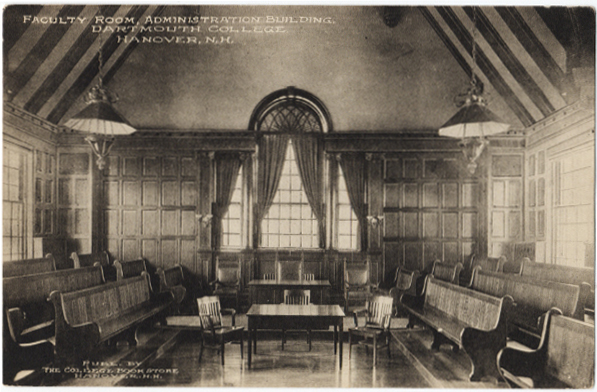
An earlier view of the room. Some of the benches, with their numbered seating spaces, can be found in the corridors of Parkhurst Hall.
Peter Christian’s interior removed
Peter Christian’s (in the New York Times; in New London) was a Hanover tavern that occupied a basement at 35 South Main Street lined with dark wood, including beams salvaged from the oldest house in Hanover, the 1770 Storrs’ Tavern (D.K.E.). During the mid-1990s, Old Pete’s replaced it, then another tavern, then The Wrap. The Wrap has become a burrito place called Boloco, for “Boston Local Company.” (One customer was overheard describing a burrito to her deprived child as “like a wrap, but warm.”) When the wrap or the burrito place moved in, all of the old, dark interior was ripped out and presumably sold off. A Boloco clerk said that someone stole the bar one night.
E.K. Smith’s post is down but survives
The possibly-1860s granite post mentioned earlier as surviving the Kemeny Hall construction has been pulled, but the fact that it remains at the construction site encourages the speculation that it will be replaced when the building is finished:
Wren Room source identified
Dartmouth Life reports on Professor Spicer’s discovery that architect Jens Larson based Sanborn House’s Wren Room on the salon at Bolton House, Linconshire (1685-1686, William Winde).
[Update 05.17.2006: Rod Miller made this attribution in his 1998 dissertation on Jens Larson, p. 28.]
Baker Library’s Parisian “twin”
Baker Library has a variety of “twins” at other colleges, libraries that also look like Independence Hall, but its most unexpected sibling is the Maison Internationale at the City University of Paris (basic information), designed by the same architect, Jens Larson.
Although it is all chateau and no Philadelphia, it still has the flanking wings and the long reading room, as seen in an article in Label France magazine and interior photos.
Even the arcade joining the wings, a feature that was contemplated but not built at Baker, is very “Larson” and calls to mind the arcade joining Baker to Sanborn House.
